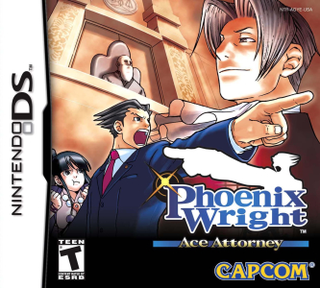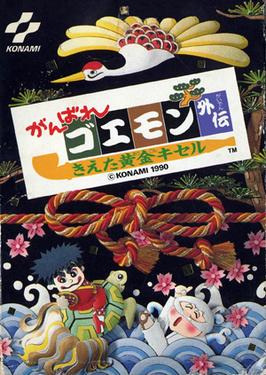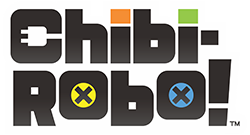
Phoenix Wright: Ace Attorney is a visual novel adventure game developed and published by Capcom. It was released in 2001 for the Game Boy Advance in Japan and has been ported to multiple platforms. The 2005 Nintendo DS version, titled Gyakuten Saiban Yomigaeru Gyakuten in Japan, introduced an English language option, and was the first time the game was released in North America and Europe. It is the first entry in the Ace Attorney series; several sequels and spin-offs were produced, while this game has seen further ports and remasters for computers, game consoles, and mobile devices.

Final Fantasy Legend II, known in Japan as SaGa 2: Hihou Densetsu, is a role-playing video game developed and published by Square for the Game Boy. The second entry in the SaGa series, it was released in 1990 in Japan, and in 1991 in North America. A remake for the Nintendo DS was released in 2009 by Square Enix, remaining exclusive to Japan. The Game Boy version was later ported to the Nintendo Switch and released worldwide by Square Enix in 2020, with later ports to Android, iOS and Microsoft Windows in 2021.

The Legendary Starfy is a video game series developed by Tose and published by Nintendo. The series is the only franchise for which Tose owns the copyright, which they share with Nintendo; as a result, Tose, which normally does not put their company name on their games, does so in the Starfy series. The series began in 2002 with Densetsu no Stafy for the Game Boy Advance, and four sequels were released. For its first seven years, Starfy games were not released outside Japan. The fifth and latest game in the series was released as The Legendary Starfy in North America on June 8, 2009. In July 2024, the first three titles were officially released via the Nintendo Switch Online service.
Metal Max is a role-playing video game series created by Hiroshi Miyaoka and his studio Crea-Tech. The first title was developed by Crea-Tech in collaboration with Data East, and was published by Data East in 1991. Due to the bankruptcy of Data East and trademark problems, some titles were released by Success co. under the title Metal Saga. Since the trademark issue was resolved by Enterbrain, some games in the series have been released under the title Metal Max again.

Lucky Star is a Japanese four-panel comic strip manga series by Kagami Yoshimizu. It has been serialized in Kadokawa Shoten's Comptiq magazine since December 2003. Cameo strips were published in other magazines such as Shōnen Ace and others. There is no ongoing plot in Lucky Star, which typically focuses on the daily lives of the characters.

Tose Co., Ltd. is a Japanese video game development company based in Kyoto. It is mostly known for developing Nintendo's Game & Watch Gallery series, various Dragon Ball games, as well as other Nintendo products. Tose has developed or co-developed over 1,000 games since the company's inception in 1979, but is virtually never credited in the games themselves. Tose maintains a policy of having no creative input into the work they do, going so far as to refuse to put their names in the credits for most of the games they work on. As such, Tose has gained a reputation for being a "ghost developer".

Ganbare Goemon Gaiden: Kieta Ōgon Kiseru is a video game in the Ganbare Goemon series, released for the Family Computer on January 5, 1990 in Japan. This game introduced many characters that appeared later in the series, such as Yae. It is the first Goemon role-playing game, and the third Goemon game to appear on a Nintendo system.

Mega Man Star Force: Pegasus, Mega Man Star Force: Leo, and Mega Man Star Force: Dragon are 2006 action role-playing video games developed and published by Capcom for the Nintendo DS handheld video game console; combined, they are the first game in the Mega Man Star Force series, a sub series of the greater Mega Man franchise—and a follow-up to the Mega Man Battle Network series. It takes place in the years of 220X, in which technology has advanced to the point where the world is now connected through EM waves. The game follows Geo Stelar, a fifth-grader in Echo Ridge who merges with an FM-ian named Omega-Xis after mourning the supposed death of his father.

Taiko no Tatsujin is a video game series created by Namco. In the games, players simulate playing a taiko drum in time with music. The series has released games for the arcade and for console and mobile platforms including PlayStation 2, Advanced Pico Beena, PlayStation Portable, Nintendo DS, Wii, Nintendo 3DS, Wii U, PlayStation Vita, PlayStation 4, Nintendo Switch, Xbox One, Xbox Series X/S, Microsoft Windows, iOS, Android and Japanese feature phones.

Densetsu no Stafy is a platform video game developed by Tose and published by Nintendo for the Game Boy Advance system exclusively in Japan on September 6, 2002. It is the first game in the series The Legendary Starfy. It received its first official re-release on the Nintendo Switch Online + Expansion Pack on July 12, 2024, in all regions for the first time along the other GBA entries.

Densetsu no Stafy 2 is a platform video game developed by Tose and published by Nintendo for the Game Boy Advance in Japan on September 5, 2003. It is the second game in The Legendary Starfy series. It received its first official re-release on the Nintendo Switch Online + Expansion Pack on July 12, 2024, in all regions for the first time along the other GBA entries.

Densetsu no Stafy 3 is a platforming video game developed by Tose and published by Nintendo for the Game Boy Advance only in Japan on August 5, 2004. It is the third game in The Legendary Starfy series, as well as the third and last title of the series developed and released for the Game Boy Advance. Later, its sequel, Densetsu no Stafy 4, was developed for the Nintendo DS. It received its first official re-release on the Nintendo Switch Online + Expansion Pack on July 12, 2024, in all regions for the first time along the other GBA entries.

Nintendo Software Planning & Development Division, commonly abbreviated as Nintendo SPD, was a Japanese research, planning and development division owned by Nintendo and housed inside the Nintendo Development Center in Kyoto, Japan. The division had two departments: Software Planning & Development Department, which primarily co-produced games with external developers; and Software Development & Design Department, which primarily developed experimental and system software. The division was created during a corporate restructuring in September 2003, with the abolition of the Nintendo R&D1 and Nintendo R&D2 departments.

The Legendary Starfy, known as Densetsu no Stafī: Taiketsu! Daīru Kaizokudan in Japan, is a 2008 platform video game developed by Tose and published by Nintendo for the Nintendo DS handheld video game console. It is the fifth game in The Legendary Starfy video game series. On June 8, 2009, the game became the first in the series to be released outside Japan.

Irozuki Tingle no Koi no Balloon Trip is an adventure video game developed by Vanpool and published by Nintendo for the Nintendo DS. It is a sequel to the game Freshly-Picked Tingle's Rosy Rupeeland and was released in Japan on August 6, 2009. As with its predecessor, the game focuses on Tingle, a character from The Legend of Zelda series.

Chibi-Robo! is a series of adventure video games developed by Skip Ltd. and published by Nintendo. The franchise follows a series of tiny robotic units known as Chibi-Robo, whose purpose is to spread Happiness. Recurring game elements of the franchise include monitoring Chibi-Robo's battery usage at all times, and cleaning Chibi-Robo's nearby environment through a variety of methods in order to collect "Happy Points," the game’s collectible representation of the happiness you instill in others. While the primary purpose of a Chibi-Robo is to assist humans, they have also been shown to assist animals, sentient alien life, and even living toys.

Shiren the Wanderer 4: The Eye of God and the Devil's Navel is a role-playing video game developed by Chunsoft and published by Spike. It is the fourth main entry in the Shiren the Wanderer series, which itself is a part of the larger Mystery Dungeon series. The game was originally released for the Nintendo DS in 2010; an expanded port was released for the PlayStation Portable in 2012 entitled Mystery Dungeon: Shiren the Wanderer 4 Plus: The Eye of God and the Devil's Navel.

Shiren the Wanderer GB2: Magic Castle of the Desert is a roguelike role-playing video game developed by Chunsoft. It is part of the Mystery Dungeon series, and is a sequel to Shiren the Wanderer GB: Monster of Moonlight Village. It was originally released for the Game Boy Color by Chunsoft in 2001. A Nintendo DS remake was released by Sega later in 2008.


















